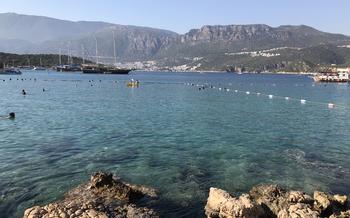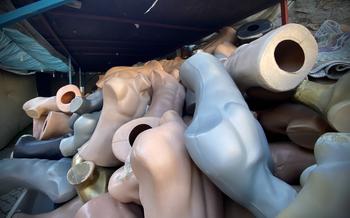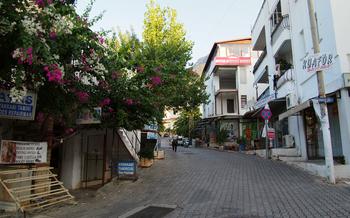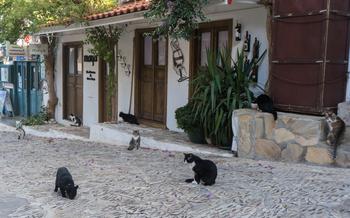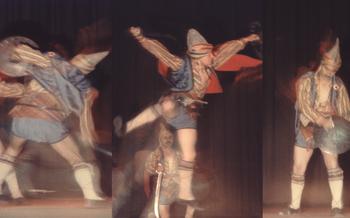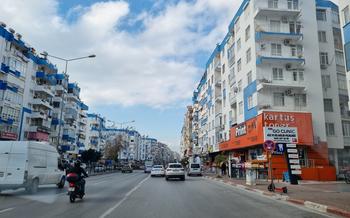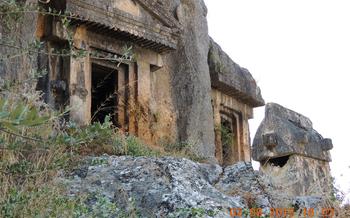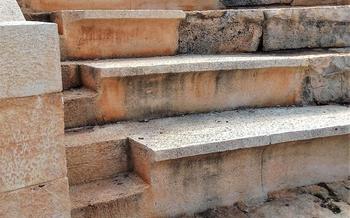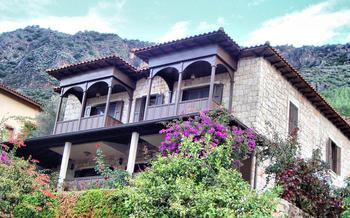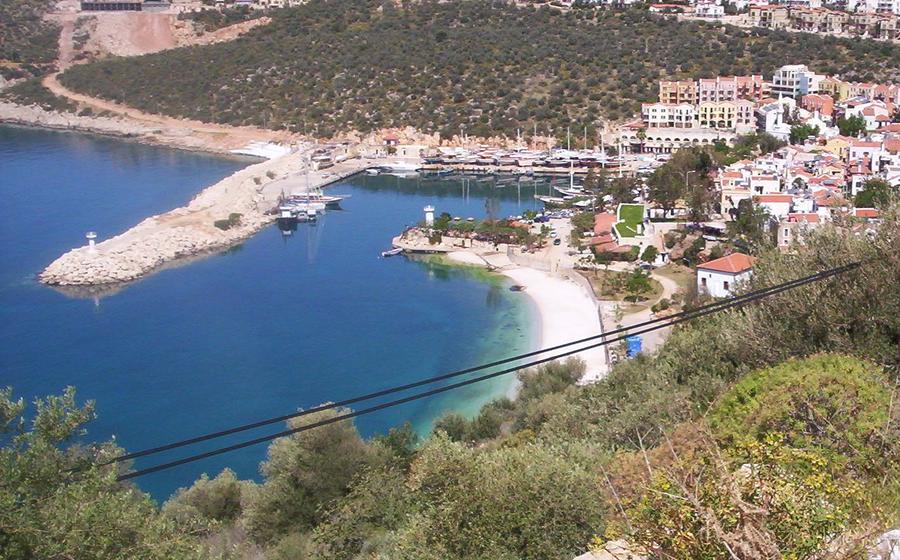
Hellenistic Theatre in Kas
- Historical Significance
- Location and Directions
- Architectural Features
- Acoustics and Performances
- Restoration and Preservation
- Admission and Hours
- Guided Tours and Self-Exploration
- Surrounding Ruins and Sites
- Local Culture and Traditions
- Souvenirs and Local Products
- Accessibility for Differently-Abled Visitors
- Dining Options and Local Delicacies
Historical Significance
The ancient city of Antiphellos, where the Hellenistic Theatre stands today, was a prominent city-state in the Lycian League, a powerful confederation of cities in ancient Anatolia. Situated on the Mediterranean coast, Antiphellos served as a crucial port city, facilitating trade and cultural exchange between the Mediterranean and the Anatolian hinterland.
Built in the 4th century BC, the theatre was a central gathering place for the citizens of Antiphellos. It was not just a venue for entertainment but also a stage for religious ceremonies, political assemblies, and public celebrations. The theatre's strategic location, nestled at the foot of a hill overlooking the sea, provided excellent acoustics and a stunning backdrop for performances.
The theatre fell into disuse with the decline of the Lycian League and the rise of the Roman Empire. Its existence was forgotten, and the structure was buried under layers of sediment and vegetation. In the 19th century, European travelers and archaeologists rediscovered the ruins of Antiphellos, including the theatre, sparking renewed interest in the region's rich history.
Location and Directions
Kas is easily accessible from major cities in Turkey, including Antalya, Dalaman, and Fethiye. From Antalya, take the D400 highway and follow the signs to Kas. From Dalaman, take the D350 highway and connect to the D400 near Fethiye. From Fethiye, take the D400 highway directly to Kas.
Once in Kas, the Hellenistic Theatre is within walking distance from the town center. From the picturesque Kas Harbor, follow Atatürk Caddesi, the main street, for about 10 minutes until you reach the theatre. Alternatively, you can take a short taxi ride or rent a bicycle for a scenic ride to the theatre.
The theatre is situated on a hilltop overlooking the town and the Mediterranean Sea. It is surrounded by other historical sites and attractions, including the Kastellorizo Island, the Lycian Rock Tombs, and the Ancient City of Antiphellos. These landmarks provide a convenient way to orient yourself and plan your exploration of Kas.
Architectural Features
The Hellenistic Theatre in Kas, Turkey, showcases remarkable architectural features that reflect the ingenuity and artistry of the Hellenistic period. With a seating capacity of approximately 2,000 spectators, the theatre is an impressive sight to behold. Its design adheres to the classical Greek theatre layout, comprising a circular orchestra, a raised stage, and concentric rows of seating.
Constructed primarily using local limestone, the theatre boasts a sturdy and durable structure. The seating tiers, known as "cavea," are divided into wedge-shaped sections by radiating staircases. The front rows feature individual stone seats, while the upper rows have continuous benches. The stage area, or "skene," is adorned with intricate carvings and decorative elements, adding to the theatre's overall grandeur.
Unique to this theatre is its integration of natural acoustics. The carefully designed seating arrangement and the theatre's hillside location create exceptional reverberation, ensuring that performances could be heard clearly from every seat. This remarkable acoustic quality has made the theatre a popular venue for various performances throughout history.
Acoustics and Performances
The Hellenistic Theatre in Kas was renowned for its exceptional acoustics, a testament to the skill and expertise of its ancient builders. Its unique design allowed sound to carry clearly throughout the auditorium, ensuring that every spectator could hear the performers without strain. This remarkable acoustic quality made the theatre an ideal venue for a variety of performances, including plays, concerts, and religious ceremonies.
The theatre's acoustics were particularly well-suited for dramatic performances. The actors' voices could be heard clearly from every seat, creating an immersive and engaging experience for the audience. The theatre's intimate size also contributed to its acoustic excellence, as it allowed for a more direct connection between the performers and the spectators.
In addition to plays, the theatre was also used for musical performances. The acoustics were ideal for amplifying the sound of musical instruments, creating a rich and resonant soundscape. Concerts and recitals were popular events, and the theatre's acoustics allowed the audience to fully appreciate the musicians' skill and artistry.
The theatre's acoustics also played a role in religious ceremonies. The clear transmission of sound was essential for ensuring that the participants could hear the prayers and rituals being performed. The theatre's sacred atmosphere was further enhanced by its acoustics, which created a sense of awe and reverence among the worshippers.
One of the most famous legends associated with the theatre's acoustics is the story of a musician who was able to play his flute so beautifully that the sound carried across the entire town. The music was so enchanting that it drew people from all over to listen, and the musician became known throughout the region for his extraordinary talent.
To this day, the Hellenistic Theatre in Kas continues to be used for occasional performances and events. Its excellent acoustics and intimate atmosphere make it a popular venue for concerts, plays, and other cultural events. Visitors to Kas can experience the theatre's remarkable acoustics firsthand and appreciate the skill and artistry of the ancient builders who created this architectural masterpiece.
Restoration and Preservation
The Hellenistic Theatre in Kas has undergone several restoration and preservation efforts over the years to maintain its historical integrity. In the late 19th century, the theatre was partially excavated by French archaeologists, who uncovered the stage area and some of the seating rows. However, it was not until the 1960s that comprehensive restoration work began.
During this period, the theatre was extensively excavated, and many of its structural elements were repaired or reconstructed. The stage building was restored, and the seating rows were cleaned and reinforced. In addition, a new drainage system was installed to protect the theatre from water damage.
Despite these efforts, the theatre still faced challenges, such as erosion and damage from weathering. In the 21st century, further restoration work was undertaken to address these issues. The seating rows were repaired and consolidated, and new protective measures were put in place to prevent further deterioration.
Today, the Hellenistic Theatre in Kas stands as a well-preserved monument to its ancient past. It serves as a reminder of the rich cultural heritage of the region and continues to attract visitors from around the world.
Admission and Hours
Admission to the Hellenistic Theatre in Kas is free of charge, allowing visitors to explore this ancient marvel without any financial barriers. Its hours of operation are typically from 8:00 AM to 5:00 PM, providing ample time to wander through the ruins and soak in the historical atmosphere. However, it's always advisable to check with local authorities or tourist information centers for any seasonal variations or special events that may affect the theatre's accessibility.
For an optimal experience, plan your visit during the shoulder months (April-May and September-October) when the weather is pleasant, and the crowds are smaller. The theatre's location offers respite from the midday sun, making it an ideal spot to escape the heat and immerse yourself in history. Whether you're an early bird or prefer the golden hues of sunset, the Hellenistic Theatre in Kas is waiting to unveil its timeless charm.
Guided Tours and Self-Exploration
The Hellenistic Theatre in Kas offers a unique opportunity for visitors to explore the ancient world. To fully appreciate the theatre's history and significance, consider joining a guided tour. These tours, led by experienced historians or archaeologists, provide in-depth insights into the theatre's construction, performances, and cultural context. You can ask questions, learn about the lives of the ancient Greeks and Romans, and gain a deeper understanding of the theatre's role in their society.
For those who prefer to wander at their own pace, self-exploration is also an excellent option. The theatre is well-marked with informative signs that provide historical context and explain the different sections of the structure. You can take your time to explore the seating area, the stage, and the orchestra pit, imagining what it must have been like to attend a performance in ancient times.
Several resources and apps are available to enhance your self-guided tour. The Kas Museum offers audio guides that provide detailed information about the theatre's history and architecture. Alternatively, you can download historical context apps that offer interactive maps, 3D models, and augmented reality experiences that bring the ancient world to life.
Surrounding Ruins and Sites
The Hellenistic Theatre in Kas is just one of many ancient wonders in the region. Visitors can embark on a journey through time by exploring the nearby ruins and historical sites that tell the story of Lycia's rich past.
A short walk from the theatre leads to the ancient city of Antiphellos, where visitors can wander among the remains of temples, agora, and other public buildings. The site is particularly known for its well-preserved city walls, which offer breathtaking views of the surrounding landscape.
Another must-visit site is the Kas Necropolis, located on a hilltop overlooking the town. This ancient cemetery features a collection of elaborate rock-cut tombs, each adorned with intricate carvings and inscriptions. The tombs provide a glimpse into the burial customs and beliefs of the Lycians.
For those seeking a more in-depth exploration, a visit to the Kas Archaeological Museum is a must. The museum houses a vast collection of artifacts unearthed from the region, including sculptures, pottery, and jewelry. Visitors can learn about the history, culture, and daily life of the ancient Lycians through these fascinating exhibits.
By combining a visit to the Hellenistic Theatre with these surrounding ruins and sites, visitors can gain a comprehensive understanding of Kas's rich history and cultural heritage. It's an opportunity to step back in time and experience the grandeur of the ancient world.
An ideal itinerary for a day of exploration could start with a visit to the Hellenistic Theatre, followed by a walk through the ancient city of Antiphellos. After lunch at a local restaurant, visitors can head to the Kas Necropolis to admire the rock-cut tombs. The day can end with a visit to the Kas Archaeological Museum to delve deeper into the region's history. This itinerary offers a well-rounded experience of Kas's ancient treasures.
Local Culture and Traditions
The Hellenistic Theatre in Kas is not merely an ancient monument; it holds deep cultural significance for the local community. Throughout history, the theatre has served as a venue for various traditional events and festivals, showcasing the region's rich cultural heritage.
One of the most notable events held at the theatre is the annual Kas Drama Festival. This festival brings together local and international theatre companies to perform plays and showcase their talents. The festival creates a vibrant atmosphere in Kas, attracting theater enthusiasts from far and wide.
Another significant cultural event held at the theatre is the Kas Music Festival. This festival features performances by local and international musicians, filling the air with melodies that reverberate through the ancient stone walls.
To immerse yourself in the local culture, consider attending one of these festivals during your visit. These events offer a unique opportunity to experience the warmth and hospitality of the local people while enjoying the theatre's enchanting atmosphere.
Souvenirs and Local Products
The vicinity of the Hellenistic Theatre in Kas offers a treasure trove of souvenir shops and local markets where visitors can purchase unique mementos of their visit. These shops and markets are not just places to buy souvenirs; they are also cultural hubs that provide a glimpse into the vibrant local traditions and craftsmanship.
One of the most popular souvenirs from Kas is the traditional Turkish carpet. Handcrafted by skilled artisans, these carpets are renowned for their intricate designs, vibrant colors, and exceptional durability. Visitors can find a wide variety of carpets to choose from, each with its own unique story to tell.
Another popular souvenir is handmade pottery. Kas is home to a thriving community of potters who create beautiful and functional ceramic pieces. From decorative plates and bowls to intricate vases and sculptures, there is something for every taste and budget. Visitors can watch the potters at work and learn about the traditional techniques they use.
For those looking for something truly unique, there are several shops in Kas that sell handmade jewelry. Local artisans create stunning pieces using a variety of materials, including silver, gold, and gemstones. From delicate necklaces and earrings to bold statement pieces, there is sure to be a piece of jewelry that catches the eye.
No visit to Kas is complete without trying the local delicacies. Visitors can purchase traditional Turkish sweets, such as baklava and Turkish delight, from the many shops and markets near the theatre. These sweets are made with fresh ingredients and are a delicious way to experience the local cuisine.
Accessibility for Differently-Abled Visitors
The Hellenistic Theatre in Kas is committed to providing an accessible and inclusive experience for differently-abled visitors. The theatre features ramps and designated seating areas that allow wheelchair users and visitors with limited mobility to enjoy the site comfortably. The theatre staff is also trained to assist visitors with any needs they may have.
While the theatre is generally accessible, there are a few challenges that differently-abled visitors might face. The uneven terrain surrounding the theatre may make it difficult for wheelchair users to navigate independently. Additionally, the theatre's seating is arranged in tiers, which may require assistance for those with limited mobility to reach their seats.
To overcome these challenges, visitors can request assistance from the theatre staff, who are always willing to help. Alternatively, visitors can opt for a self-guided tour of the theatre's exterior, which offers stunning views and historical insights without the need to navigate the seating areas.
For those with limited mobility who wish to experience the theatre's performances, it is recommended to book accessible seating in advance. Visitors can also contact the theatre directly to inquire about any additional accommodations or assistance they may require.
Dining Options and Local Delicacies
Before or after exploring the Hellenistic Theatre in Kas, take the opportunity to savor the delectable local cuisine. A plethora of restaurants and cafes are scattered around the theatre, offering a diverse range of dining experiences. From traditional Turkish fare to international flavors, there's something to satisfy every palate.
Indulge in the aromatic delights of freshly grilled kebabs, succulent mezzes, and tantalizing pide (Turkish flatbread). For a taste of the sea, try the freshly caught fish, expertly prepared and seasoned with local herbs and spices. Vegetarian and vegan options are also available, showcasing the region's rich selection of fresh vegetables and pulses.
To enhance your culinary journey, pair your meal with a glass of locally produced wine or traditional Turkish tea. For a truly unique experience, opt for a restaurant with panoramic views of the Mediterranean Sea, providing a breathtaking backdrop to your meal.
